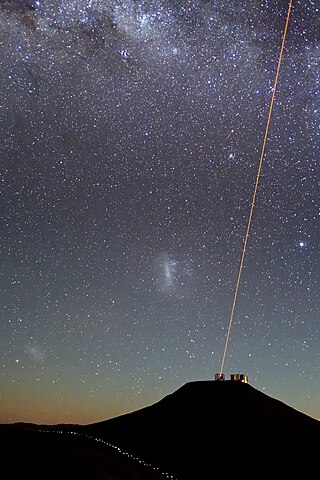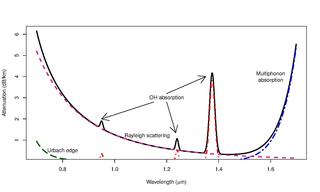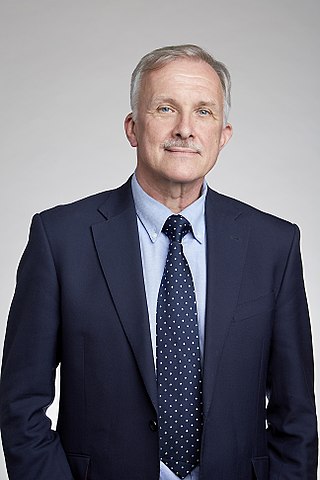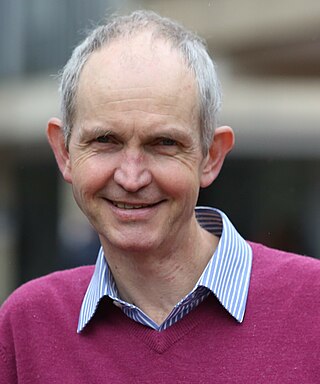Related Research Articles

An optical amplifier is a device that amplifies an optical signal directly, without the need to first convert it to an electrical signal. An optical amplifier may be thought of as a laser without an optical cavity, or one in which feedback from the cavity is suppressed. Optical amplifiers are important in optical communication and laser physics. They are used as optical repeaters in the long distance fiberoptic cables which carry much of the world's telecommunication links.

In fiber-optic communications, wavelength-division multiplexing (WDM) is a technology which multiplexes a number of optical carrier signals onto a single optical fiber by using different wavelengths of laser light. This technique enables bidirectional communications over a single strand of fiber, also called wavelength-division duplexing, as well as multiplication of capacity.

Photonics is a branch of optics that involves the application of generation, detection, and manipulation of light in form of photons through emission, transmission, modulation, signal processing, switching, amplification, and sensing. Photonics is closely related to quantum electronics, where quantum electronics deals with the theoretical part of it while photonics deal with its engineering applications. Though covering all light's technical applications over the whole spectrum, most photonic applications are in the range of visible and near-infrared light. The term photonics developed as an outgrowth of the first practical semiconductor light emitters invented in the early 1960s and optical fibers developed in the 1970s.
All-silica fiber, or silica-silica fiber, is an optical fiber whose core and cladding are made of silica glass. The refractive index of the core glass is higher than that of the cladding. These fibers are typically step-index fibers. The cladding of an all-silica fiber should not be confused with the polymer overcoat of the fiber.

An optical fiber, or optical fibre in Commonwealth English, is a flexible glass or plastic fiber that can transmit light from one end to the other. Such fibers find wide usage in fiber-optic communications, where they permit transmission over longer distances and at higher bandwidths than electrical cables. Fibers are used instead of metal wires because signals travel along them with less loss; in addition, fibers are immune to electromagnetic interference, a problem from which metal wires suffer. Fibers are also used for illumination and imaging, and are often wrapped in bundles so they may be used to carry light into, or images out of confined spaces, as in the case of a fiberscope. Specially designed fibers are also used for a variety of other applications, such as fiber optic sensors and fiber lasers.
Optical networking is a means of communication that uses signals encoded in light to transmit information in various types of telecommunications networks. These include limited range local-area networks (LAN) or wide-area networks (WAN), which cross metropolitan and regional areas as well as long-distance national, international and transoceanic networks. It is a form of optical communication that relies on optical amplifiers, lasers or LEDs and wave division multiplexing (WDM) to transmit large quantities of data, generally across fiber-optic cables. Because it is capable of achieving extremely high bandwidth, it is an enabling technology for the Internet and telecommunication networks that transmit the vast majority of all human and machine-to-machine information.
Philip St. John Russell, FRS, is Emeritus Director of the Max Planck Institute for the Science of Light in Erlangen, Germany. His area of research covers "photonics and new materials", in particular the examination of new optical materials, especially of photonic crystal fibres, and more generally the field of nano- and micro-structured photonic materials.
A fiber laser is a laser in which the active gain medium is an optical fiber doped with rare-earth elements such as erbium, ytterbium, neodymium, dysprosium, praseodymium, thulium and holmium. They are related to doped fiber amplifiers, which provide light amplification without lasing.

Fiber-optic communication is a method of transmitting information from one place to another by sending pulses of infrared or visible light through an optical fiber. The light is a form of carrier wave that is modulated to carry information. Fiber is preferred over electrical cabling when high bandwidth, long distance, or immunity to electromagnetic interference is required. This type of communication can transmit voice, video, and telemetry through local area networks or across long distances.
Filling factor, is a quantity measuring the efficiency of absorption of pump in the core of a double-clad fiber.
Photodarkening is an optical effect observed in the interaction of laser radiation with amorphous media (glasses) in optical fibers. Until now, such creation of color centers was reported only in glass fibers. Photodarkening limits the density of excitations in fiber lasers and amplifiers. The experimental results suggest that operating at a saturated regime helps to reduce photodarkening.

IPG Photonics is an American manufacturer of fiber lasers. IPG Photonics developed and commercialized optical fiber lasers, which are used in a variety of applications including materials processing, medical applications and telecommunications. IPG has manufacturing facilities in the United States, Germany, Russia and Italy.

In infrared optical communications, C-band refers to the wavelength range 1530–1565 nm, which corresponds to the amplification range of erbium doped fiber amplifiers (EDFAs). The C-band is located around the absorption minimum in optical fiber, where the loss reaches values as good as 0.2 dB/km, as well as an atmospheric transmission window. The C-band is located between the short wavelengths (S) band (1460–1530 nm) and the long wavelengths (L) band (1565–1625 nm). It includes the 50 GHz-spaced DWDM ITU channels 16 to 59.
Robert J. Mears is an English physicist and engineer. In the 1980s, Dr. Mears invented and demonstrated the Erbium Doped Fiber Amplifier (EDFA) with the help of members of the Optoelectronics Research Group led by Alec Gambling and David Payne. In 2001 he founded Atomera, and as CTO led the invention and development of Mears Silicon Technology (MST), a method for improving the mobility and other characteristics of semiconductor devices. Mears has authored and co-authored more than 250 publications and patents, and is co-inventor of 46 granted US patents. He is an Emeritus Fellow of Pembroke College, Cambridge.
An erbium-doped waveguide amplifier is a type of an optical amplifier enhanced with erbium. It is a close relative of an EDFA, erbium-doped fiber amplifier, and in fact EDWA's basic operating principles are identical to those of the EDFA. Both of them can be used to amplify infrared light at wavelengths in optical communication bands between 1500 and 1600 nm. However, whereas an EDFA is made using a free-standing fiber, an EDWA is typically produced on a planar substrate, sometimes in ways that are very similar to the methods used in electronic integrated circuit manufacturing. Therefore, the main advantage of EDWAs over EDFAs lies in their potential to be intimately integrated with other optical components on the same planar substrate and thus making EDFAs unnecessary.

(James) Roy TaylorFREng is Professor of Ultrafast Physics and Technology at Imperial College London.

David John Richardson is a Professor and Deputy Director of the Optoelectronics Research Centre at the University of Southampton.

Jonathan C. Knight, is a British physicist. He is the Pro Vice-Chancellor (Research) for the University of Bath where he has been Professor in the Department of Physics since 2000, and served as head of department. From 2005 to 2008, he was founding Director of the university's Centre for Photonics and Photonic Materials.
Anne C. Tropper is a Professor of Physics at the University of Southampton. Her work considers solid-state and semiconductor lasers; specifically the development of ytterbium-doped silica fibre lasers and Vertical External-Cavity Surface-Emitting Lasers. She was elected a Fellow of The Optical Society in 2006, and awarded the 2021 SPIE Maiman Laser Award for her contributions to laser source science and technology.
Masataka Nakazawa is a Japanese researcher in optical communication engineering. He is a distinguished professor at Tohoku University in Japan. His pioneering work on erbium-doped fiber amplifier (EDFA) has made a significant contribution to the development of global long-distance, high-capacity optical fiber network.
References
- 1 2 "List of Fellows". Archived from the original on 8 June 2016. Retrieved 23 October 2014.
- ↑ S.B.Poole, J.E.Townsend, D.N.Payne, M.E.Fermann, G.J.Cowle, R.I.Laming, P.R.Morkel, Characterisation of special fibres and fibre devices IEEE Journal of Lightwave Technology Special Issue 1989 Vol.7(8) pp.1242-1255
- ↑ R. J. Mears, L. Reekie, I. M. Jauncey, and D. N. Payne, in Digest of Topical Meeting on Optical Fiber Communication (Optical Society of America, Washington, D.C., Jan 1987), Paper W12; R. J. Mears, L. Reekie, S. B. Poole, and D. N. Payne, Electron. Lett. 22,159 (Sept 1986)
- ↑ Mears, R.J.; Reekie, L.; Poole, S.B.; Payne, D.N. (1986). "Low-threshold tunable CW and Q-switched fibre laser operating at 1.55 μm". Electronics Letters. 22 (3): 159. Bibcode:1986ElL....22..159M. doi:10.1049/el:19860111. ISSN 0013-5194.
- ↑ Mears, R.J.; Reekie, L.; Jauncey, I.M.; Payne, D.N. (1987). "Low-noise erbium-doped fibre amplifier operating at 1.54μm". Electronics Letters. 23 (19): 1026. Bibcode:1987ElL....23.1026M. doi:10.1049/el:19870719. ISSN 0013-5194.
- ↑ E. Desurvire, J.R. Simpson and P.C. Becker, High-gain erbium-doped traveling-wave fiber amplifier, Optics letters, Vol. 12, No. 11, November 1987
- ↑ R.J.Mears, L.Reekie, S.B.Poole, D.N.Payne, Neodymium-doped silica single-mode fibre lasers, Electronics Letters 1985 Vol.21 (17) pp.738-740
- ↑ Y.Jeong, J.K.Sahu, S.Baek, C.Alegria, D.B.S.Soh, C.Codemard, V.Philippov, D.J.Richardson, D.N.Payne, J.Nilsson, Ytterbium-doped double-clad large-core fibre lasers with kW-level continuous-wave output power, CLEO/IQEC 2004 San Francisco 16–21 May 2004 CMS
- ↑ Pioneering research aims to make the internet faster Archived 2016-10-21 at the Wayback Machine , University of Southampton Optoelectronics Research Centre, 2011-01-28, with two audio recordings of Payne
- ↑ David N. Payne Elected Chairman of the Marconi Society, http://marconisociety.org/press/payneelected.html Archived 2016-03-25 at the Wayback Machine
- ↑ A GOLDEN TOUCH: PROFESSOR DAVID PAYNE CBE FREng FRS, http://www.ingenia.org.uk/ingenia/issues/issue38/issue38_profile.pdf Archived 2015-09-24 at the Wayback Machine
- ↑ "No. 60367". The London Gazette (Supplement). 29 December 2012. p. 1.
- ↑ "Winners of the Second Ever VinFuture Prize Awards Unveiled". VinFuture Foundation. Cision US Inc. Cision PR Newswire. 20 December 2022. Retrieved 21 December 2022.